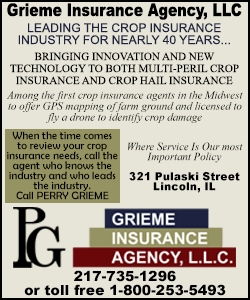|
 There is definitely a separation of opinion on this topic. Some
will say emphatically “Yes.” We need to return to some of the ways
of our past generations, in order to preserve Mother Earth. Others
will say “no,” we have to continue research and advancement if we
are going to preserve the human race by continuing to feed the world
population. There is definitely a separation of opinion on this topic. Some
will say emphatically “Yes.” We need to return to some of the ways
of our past generations, in order to preserve Mother Earth. Others
will say “no,” we have to continue research and advancement if we
are going to preserve the human race by continuing to feed the world
population.
In the last decade or so, “organic” has become a consumer buzz word
at the supermarket, but in early September when PrairiErth Farm
owner David Bishop hosted a University of Illinois crop research
field day, the talk was more than a little reminiscent of
days-gone-by. Guest speakers talked about returning to crop
rotations that included a third cash crop and or a cover crop to
protect soil from winter erosion.
Instead of using synthetic chemicals to control weeds, one guest
mentioned the return of the field cultivator as well as “walking
fields’ for weed control. For those in attendance who grew up on the
farm in the 1950s, 60s and even 70s, those were all too familiar
words reminiscent of long hot days trudging through the fields
pulling or hoeing out weeds by hand. It brought to mind, are we
farming organic or are we returning to ways of our dads and
granddads, or is it all just two ways of saying the same thing, “go
back to our roots, go back to the old ways?”
 There is a lot to consider here. Organic farming has merit when it
comes to soil conservation, and protecting water. It also has some
serious pitfalls, such as lower crop production, and more dollars
invested in labor.
Protecting waterways and ground water is a big issue. In this day
and age, we are seeing more waterway contamination than ever before.
It is coming from various sources, but it sometimes appears that it
is the American Farmer that is shouldering the majority of the blame
for harmful contaminants in our waterway. Runoff from farm chemicals
is an issue, but it isn’t the only issue. When we see legislation
before the federal government, such as WOTUS (Waters of the U.S.),
we as agricultural producers can’t help but feel we are being
targeted and blamed for all the toxins in all the water, on all the
earth.
When recently asked the question ‘have we gone too far,”
Representative to Illinois Congressional District 18, Darin LaHood,
said he wasn’t going to answer that specifically, but he would say
the federal government has gone too far. The federal government,
according to LaHood is regulating the United States right out of
business, and WOTUS is an example. Hearing about the Illinois
initiative for clean water, he said that he was very much in favor
of letting the states determine their own clean water protocol and
that getting farmers involved in the development of that plan was a
plus.
In the year 2000, “GMO” became a consumer buzz word, by accident. It
was an accidental dumping of StarLink Roundup Ready corn into a
batch of food-grade yellow corn for production of taco shells that
set many Americans on their ear. The Roundup tolerant corn was not
intended for human consumption, yet there it was in the taco shells.
The GMO (or Genetically Modified Organism) corn was just the
beginning, as doubt about the validity of mutating genes in plants
became a new soap box for environmental and health conscious
consumers.
 However, again, GMOs are not new, they just have a different name.
For years, gardeners, in particular, have enjoyed “saving seeds”
from plants they love. They have chosen the plants that performed
well, and they tagged those plants, harvested the seeds, dried them
and saved the seeds with different genetic traits for the next year.
Is GMO really any different? Scientists have isolated genetic traits
of a plant that are most desirable, and have learned how to “save’
those traits for future crop generations. The result is plants that
are stronger, more weather resistant, and greater producers.
Scientists believe adding to that genetic structure, traits that
help make the plant tolerant to certain chemicals, is just the next
natural step in creating a better product. There are those who will say we should have left well enough alone
when it comes to scientific advancements. There are many foreign
countries who will not buy our GMO grain products. Considering these
facts, perhaps there is some merit to asking the question, have we
gone too far?
On the other hand, consider this. There was once a lowly weed,
considered toxic, with small marble size red fruit. With time,
patience, and scientific breeding measures that weed is what we
commonly know today as the tomato. From a weedy plant called
teosinte with an "ear" barely an inch long has come our foot-long
ears of sweet white and yellow corn; the product of centuries of
season-by-season coaxed genetic modification.
Should we do more to conserve our soil? Of course, farmers don’t
argue that point at all. It is in everyone’s best interest to keep
the rich topsoil where it belongs in the fields. In organic farming,
the plan to save topsoil includes cover crops that hold the soil in
place and at the same time give back to the soil in the form of
nutrients and reduction of soil compaction.
In July 2016 a Nebraska farmer who utilizes GMOs, Lisa Lunz wrote,
“GMOs have allowed us and other farmers to use no-till practices, a
way of growing crops year to year without tilling the soil,
protecting it from water runoff and wind erosion. We can now hold 2
to 3 inches of rainfall, which is important because we want to
protect our waterways.” From her point of view, both farming methods
are working with the same goal in mind, preserve and protect what we
have.
[to top of second column] |

In context of plant development concerns, Lunz also stated, "GMO
technology is not an ingredient — it’s a breeding technique." And
she defends GMO usefulness in the broadest scope, "GMOs allow us to
drive toward a truly sustainable process in protecting our air,
water, soil and habitat."
In a 2013 Technology Review article, Jonathan Jones, a scientist at
the Sainsbury Laboratory in the U.K. and one of the world’s leading
experts on plant diseases, stated of genetic modification, “It’s an
overwhelmingly logical thing to do. The upcoming pressures on
agricultural production," he says, “[are] real and will affect
millions of people in poor countries.” He concludes, "It would be
perverse to spurn using genetic modification as a tool.”
Even though there seems to be plenty of arguments for moving forward
in scientific research, there are positive opinions about organic
farming as well. Organic is a “cleaner product.” In livestock
grains, there is nothing harmful. In food crops, there is no
pesticide residue that can be consumed by humans. For wildlife, the
lack of chemicals in the fields means less accumulated poisoning of
the wildlife we enjoy. Without the use of pesticides, there is a
preservation of the “good bugs” that we want to keep in the
environment, such as pollinator insects. These attributes are
inarguable points.
With the use of herbicides, American Farmers have done such a good
job of eradicating certain weeds. However, the outcome also means
less natural food sources for such as the monarch butterfly, a large
concern for many entomologists. Pesticides, for the most part, are
not species specific, meaning what kills the bug eating the corn is
also going to kill the bee that pollinates the flower garden or next
year's fruit and other productive crop blossoms.

So where should we, as a community surrounded by agriculture, land
on this issue? Maybe on the fence. There are good arguments for both
sides. But let’s cut to the bottom line. The agricultural producer
is, though it sounds a bit cliché, the steward of the earth, and it
is up to him or her to determine what that stewardship means, and
how he or she will accept that responsibility.
Looking at our future, it is estimated that the world population
will reach 9.346 billion souls by the year 2050. That is 3 B more
than the population of the year 2010, and also a 50 percent
increase: Three billion people who need housing, clothing, jobs, and
of course, food. Cities around the world are going to grow. There
will be land taken from the farming industries for housing, for
factories and other business buildings. The acres of farm ground are
going to shrink with every additional billion added to the world
figure and the demand for food is going to grow.
So, how can we sustain ourselves and our neighbors, if we don’t use
the best farm practices available?
References

|